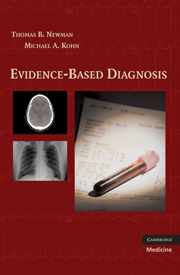Book contents
- Frontmatter
- Contents
- Preface
- Acknowledgments & Dedication
- Abbreviations/Acronyms
- 1 Introduction: understanding diagnosis and diagnostic testing
- 2 Reliability and measurement error
- 3 Dichotomous tests
- 4 Multilevel and continuous tests
- 5 Critical appraisal of studies of diagnostic tests
- 6 Screening tests
- 7 Prognostic tests and studies
- 8 Multiple tests and multivariable decision rules
- 9 Quantifying treatment effects using randomized trials
- 10 Alternatives to randomized trials for estimating treatment effects
- 11 Understanding P-values and confidence intervals
- 12 Challenges for evidence-based diagnosis
- Answers to problems
- Index
- References
9 - Quantifying treatment effects using randomized trials
Published online by Cambridge University Press: 04 August 2010
- Frontmatter
- Contents
- Preface
- Acknowledgments & Dedication
- Abbreviations/Acronyms
- 1 Introduction: understanding diagnosis and diagnostic testing
- 2 Reliability and measurement error
- 3 Dichotomous tests
- 4 Multilevel and continuous tests
- 5 Critical appraisal of studies of diagnostic tests
- 6 Screening tests
- 7 Prognostic tests and studies
- 8 Multiple tests and multivariable decision rules
- 9 Quantifying treatment effects using randomized trials
- 10 Alternatives to randomized trials for estimating treatment effects
- 11 Understanding P-values and confidence intervals
- 12 Challenges for evidence-based diagnosis
- Answers to problems
- Index
- References
Summary
Introduction
As we noted in the Preface and Chapter 1, because the purpose of doing diagnostic tests is often to decide whether or how to treat the patient, we may need to quantify the effects of treatment to decide whether to do a test. For example, if the treatment for a disease provides a dramatic benefit, we should have a lower threshold for testing for that disease than if the treatment is of marginal or unknown efficacy. In this chapter, we discuss how to quantify the effects of treatments using the results of randomized trials. In Chapter 10, we will extend the discussion to observational studies of treatment efficacy.
In a randomized trial, study participants are randomly assigned to treatment groups, and the groups are compared to determine which had better outcomes. We begin by briefly reviewing the reasons to do randomized trials, then discuss their critical appraisal. Our approach is somewhat eclectic. Our goal is to highlight issues most important for obtaining and interpreting estimates of treatment effects, not to review the entire topic of randomized trials, and our selection is based partly on issues that seem to have received insufficient attention elsewhere.
We conclude this chapter with a discussion of calculating the treatment cost per bad outcome prevented, a rough step forward in the process of quantifying risks and benefits of treatments.
- Type
- Chapter
- Information
- Evidence-Based Diagnosis , pp. 186 - 205Publisher: Cambridge University PressPrint publication year: 2009



